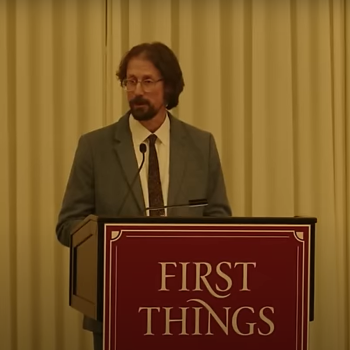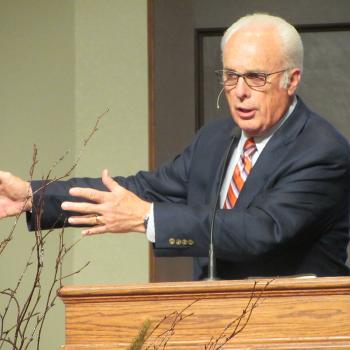
Wikimedia Commons/public domain
Many have commented that 2016 was thicker than usual in celebrity deaths. But some of those deaths have felt crueler and more poignant than others. (I for one couldn’t care less whether Prince lived or died. Sue me.) The comparatively young death of Carrie Fisher has come as a particularly sad shock to cap the year off. Tributes from various friends and associates have poured in, all emphasizing her sharp wit, humor, and honesty. It’s struck me that Fisher’s distinct un-sappiness as a person has rendered this outpouring less syrupy than the usual “dead celebrity tributes” fare. She was a complicated personality with lots of hard edges and dark corners, and she spoke about those hard, dark parts of herself with disarming candor.
Some fans are just now learning that Carrie Fisher was married: once only, to rock legend Paul Simon of Simon & Garfunkel fame. Their stormy, whirlwind romance gets extensive treatment in Peter Ames Carlin’s new Simon bio Homeward Bound, from which some pertinent excerpts are provided here. It’s painfully sad reading. Carlin paints a vivid picture of two people who had extraordinary sympatico, yet were so deeply dysfunctional that neither one could handle the other’s pain. They shared a fierce intelligence and a melancholy bent that inevitably drew them together. There are stories of titanic fights between them that would dissolve all of a sudden because they began to laugh helplessly at each other and themselves.
However, there’s no denying that their marriage was spectacularly ill-advised. Fisher’s bipolar disorder and drug abuse weren’t things that could be pushed under the rug. They were an ever-present ball and chain. Coupled with Simon’s own ongoing depression, and topped off by a tragic miscarriage, they inexorably dragged the marriage down to its doom, a mere year later. Interestingly, it was Fisher, not Simon, who made the final decision to cut it short, no doubt believing it was best for both of them.
As is typical with such things, this wasn’t the end of the story. Simon and Fisher maintained an on-again, off-again relationship for a number of years thereafter, before Fisher once again decided to break it off for good.
Musically, some of Simon’s best work came out of this relationship, most famously the song “Graceland.” Fisher is the “she” who “comes back to tell me she’s gone, as if I didn’t know that, as if I didn’t know my own bed.” However, Simon wrote another song about their relationship that slipped through the cracks at the time: the title track for a flop project called Hearts and Bones, which has been revived as something of a cult classic in recent years. While the stature of “Graceland” is undeniable, and the track understandably more ear-catching, “Hearts and Bones” is, for my money, the deeper and more poignant lyric of the two. It traces “the arc of a love affair” between “one and one half wandering Jews” (Fisher was half-Jewish), from marriage to divorce. One might mistakenly think it was written in the wake of their separation, but eerily, it was actually written on the cusp of their marriage.
In hindsight, of course, it wasn’t so difficult for Paul or anyone else to foresee what would happen. (Which raises the unromantic question, “Then why the hell did you do it, idiots?”) But, setting aside the obvious, this lyric is full of some truly gorgeous lines. Here, the speaker looks back (as Paul looks ahead) to their wedding day:
Thinking back to the season before
Looking back through the cracks in the door
Two people were married
The act was outrageous
The bride was contagious
She burned like a bride
These events may have had some effect
On the man with the girl by his side
The arc of a love affair
His hands rolling down her hair
Love like lightning, shaking till it moans
Hearts and bones
Hearts and bones
Hearts and bones
Towards the end, the speaker reflects that though they have “returned to their natural coasts” (Carrie to California, Paul to New York), the bond they made can never be wholly unmade: “You take two bodies and you twirl them into one/Their hearts and their bones/Aw, and they won’t come undone.” As a literate person and an ethnic Jew, Simon almost certainly was harking back to Adam and Eve (“bone of my bone, flesh of my flesh”), as well as Jesus’ words that in marriage, man and woman shall be no more two, but one flesh. It’s interesting to see someone who was the last person to exemplify Christian sexual mores nevertheless recognize this truth with such clarity. Marriage is natural. Divorce is unnatural. This is an incontrovertible fact of life.
I’ve had this song in rotation for a few years. And true to my impulse to play mix-and-match with art in general and music in particular, I’ve often rotated it in tandem with a different song about a different marriage: Andrew Peterson’s “Dancing in the Minefields.” Here, Peterson takes a personal look at his own union with his wife. Their love was pledged with pawn-shop rings, amidst disapproving murmurs that they were “much too young.” Nevertheless, “we said our vows and took the leap.”
But this portrait of young love is not a sugar-coated one, as here the refrain comes in to talk about the “minefields” through which they have danced, the “storms” through which their fragile bark has sailed. “This is harder than we dreamed,” Peterson sings, “but I believe that’s what the promise is for. That’s what the promise is for.” They may not have brought the baggage of mental illness or drug addiction into their marriage, but every relationship is bound to be fraught with its own particular ups and downs. Christians aren’t immune to weakness, sin and insecurity.
Peterson is aware that a lasting marriage is a rare and precious thing: “‘I do’ are the two most famous last words: the beginning of the end.” The ache of this truth is especially sharp when you listen to this song back-to-back with “Hearts and Bones.” So what is the remedy? “To lose your life for another,” writes Peterson, is a very good place to start, or so he’s heard. When two people enter a union with their eyes open, ill-advised though it may be, once the covenant is made, this is all that remains. No doubt, like many a secular couple and too many Christian couples, Simon and Fisher entered their union with the usual caveats in mind: “If it works out… unless we change our minds… we’ll give it a try… wait and see…” But deep down, is this what they wanted? Is it what they really wanted? Listen again to “Hearts and Bones,” and you’ll hear it: an unmistakable longing for something more.
People often seem terrified by the bridge-burning commitment of marriage, but Peterson and his wife “have nothing left to fear,” because “the Son of man” is their guiding light. He is the eternal witness to their covenant, and he remains their solace and their strength, through all the chances and changes of this moral life. While it is sadly true that Christian marriages have historically not been divorce-proof, they should only fall apart if one or both spouses forgets this truth.
It may seem facile to say that like many a coupling that sprang from rock-and-roll/Hollywood soil, Simon and Fisher’s was doomed to wither and die because it wasn’t rooted in the soil of a Christian marital ethic. Yes, there were many, many factors dooming their marriage. Yes, many non-Christian couples, free of their particular kinds of baggage, have navigated marriage successfully. Yet any couple who takes their vows without grasping what Peterson and his wife have found is still launching their bark without so much as a compass. And, as I have personally witnessed, a couple who does grasp it may yet dance their way through minefields at least as treacherous as those faced by Paul and Carrie, if not more so.












